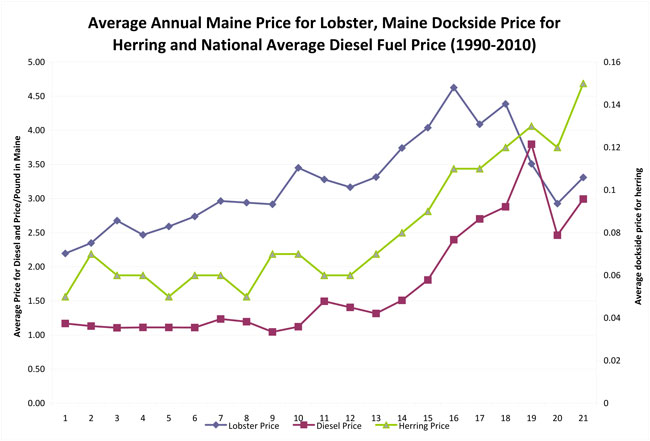Lobster Fishery Economic Conditions Past and Present
by Eric Thunberg, NOAA

The unprecedented surge in the lobster fishery that occurred during the 1990’s and, by and large, has been sustained in Maine is now a familiar story line. By comparison, the economic condition and performance of the lobster fishery has been less thoroughly examined. Available studies and recent data suggest an economic climate that is leaving the lobster fishery more vulnerable to external market forces or to environmental change. These observations are based on general economic trends occurring during 1970-2005. A more detailed discussion of these trends can be found at the following /www.nefsc.noaa.gov/publications/crd/crd0717/.
A study conducted by the University of Rhode Island during 1993 found that net operating returns averaged 49% of gross revenue, that net earnings were above per capita income for the general population, and that returns to invested capital and profit averaged 29% of gross revenue. During subsequent years, average lobster prices continued to increase (even in inflation-adjusted terms) while prices for major inputs -- fuel and bait -- were stable at least through calendar year 2000. Even though there are no published economic studies since 1993, these data indicate that profitability for most lobstermen was positive, and perhaps improving, through much of the 1990’s and into the early 2000’s. However, these positive indicators of economic performance began to change direction during the early to mid-2000’s.
Through 2004, average lobster prices were rising. At the same time, fuel prices were rising at a faster rate and ex-vessel prices for herring were trending upward. This cost-price squeeze coupled with pending reductions in the Area 1A herring Total Allowable Catch and tightening large whale protection measures prompted researchers’ interest in documenting the social and economic condition of the lobster fishery. Such a study was conducted by the Gulf of Maine Research Institute during 2006.
In addition to a number of demographic and social questions, the GMRI survey collected information on fishing activity, including cost and earnings during calendar year 2005. These data showed that returns above operating costs averaged 33% during 2005, down from an average of 49% during 1993.
Among full-time operators with a sternman, average net returns were above per capita income for the general population, but returns to invested capital averaged only 2% of gross revenue compared to 29% during 1993. This does not mean that lobster operators were operating at a loss. Rather, it means that for the majority of operators, income from lobster fishing was less than per capita income, and that the financial position for a majority of lobstermen had eroded considerably compared to the early 1990’s. Other indicators of economic vulnerability included finding that a substantial number of operators were uninsured or under-insured, and that a large number of operators were using personal financial instruments, such as credit cards or home equity loans, for operating expenses or to finance new investments.
The general financial conditions in the lobster fishery since 2005 have not improved. With the exception of 2007, the average lobster price has been declining since 2005. Fuel prices have continued to increase as has the price of herring. Notably, fuel prices spiked during 2008, just when lobster prices plummeted due to a loss of markets resulting from the failure in U.S. and overseas financial markets during October. These price effects persisted into 2009 when the average annual price in Maine fell below $3.00 per pound for the first time in more than a decade.
The economic condition affecting the lobster fishery today has squeezed profit margins and leaves more individuals vulnerable to external financial shocks like that which occurred during 2008. On a positive note, the financial position of the lobster fishery has not gone unnoticed. Spurred by events during 2008, considerable attention is being paid to improving prices received by lobstermen and to developing value-added products to keep a greater portion of the lobsters landed in Maine within the state for processing.
Less attention has been paid to understanding how much it costs to fish for lobsters in Maine. The observant reader will note that many of the conclusions that I have drawn were based on only two cost and earning studies done more than a decade apart. Fortunately, the GMRI plans to follow up its 2006 survey efforts with a more detailed survey of the financial aspects of the lobster industry, including a richer understanding of harvesting costs. Improved profitability may be achieved through improved marketing, but may also require improved cost control. Participating in the upcoming GMRI survey will be Maine lobstermen’s opportunity to provide the information needed to design initiatives that will improve the financial position of the lobster fishery in Maine.
First published in the April 2011 Maine Lobstermen’s Association newsletter. Reprinted with permission.
